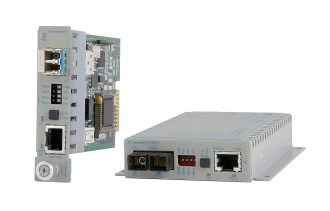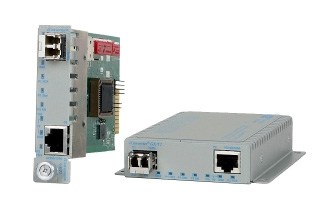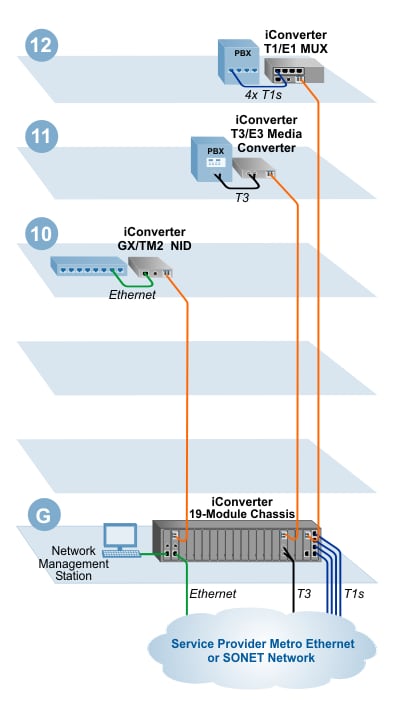Overview
Demarcation Extension, or Demarc Extension, is the network cabling from the Service Provider’s Demarcation Point to the Customer Premises Equipment. Also Known As: inside wiring, circuit extension, CPE cabling, or Riser cabling. Demarcation extension has been required since the 1984 deregulation of AT&T and the supplemental FCC rulings in the 90s. The incumbent local exchange carriers (ILEC) and other local access providers are now mandated by federal law to provide a point where the operational control or ownership changes.

The ownership of service is transferred from the local access provider to the customer at the Demarcation Point located within the Minimum Point of Entry (MPOE), where the local access provider or ILEC drops the local loop off at the customer’s site. The Demarcation point for T1 is typically Smart Jack or NIU. For Ethernet, it’s a Fiber or Copper cable hand off in a patch panel, or a Network Interface Device or NID. The demarcation can be housed in an enclosure on the side of the building or inside the building.
The Customer Premises Equipment is the LAN equipment connected to the demarcation. This can be a CSU/DSU, a Router, PBX, VoIP Gateway or a Switch. Demarcation Extension is the last piece of cabling and that connects the demarcation point to the CPE. Demarcation extension may include in-segment equipment and patch cords as required to complete the circuit’s transmission path to the edge CPE.
With any network segment, the maximum distance of copper UTP cabling is 100 meters or 328 feet. The challenge is how to deploy fiber demarcation extension that is reliable, cost-effective, and can transport TDM and/or Ethernet services.
Products
Demarcation Extension Products
T1 and T3 Media Converters

Copper to fiber T1/E1 and T3/E3 Media Converters extend T1 circuits from a service provider demarcation point. T1 media converters are is available as compact unmanaged standalone units or a managed chassis plug-in modules.
Ethernet Media Converters

Ethernet Media Converters provide seamless integration of copper and fiber optic cabling for demarcation extension. Omnitron managed and unmanaged Ethernet media converters support a variety of SFP, SFP+ and XFP Transceivers.
T1 and Ethernet Multiplexers
![]()
iConverter T1 Multiplexers transport up to sixteen independent T1/E1 circuits and Ethernet from copper links onto a fiber link or Ethernet Virtual Connection (EVC). Designed for T1 demarcation extension up to 120km, iConverter T1/E1 multiplexers are available in modular or fixed chassis configurations with 4, 8, 12 or 16 T1/E1 ports.
Multiple T1 Circuits
Demarcation Extension of Multiple T1 Circuits
When there are multiple T1 circuits and Ethernet require demarcation extension, a T1 Multiplexer is used to transport up 16 T1s and 10/100 Ethernet over fiber. iConverter T1 Multiplexers are available as managed and unmanaged devices, and are deployed in bookend configurations (the same device at each end of the fiber) to provide demarcation extension of T1s and an optional Ethernet circuit.

Riser Management
Demarcation Extension and Riser Management of T1, T3 and Ethernet Services
In this demarcation extension and riser management application, the iConverter Multi-Service Platform enables TDM and Ethernet business services to be extended to tenants on the upper floors of an office building using multi-mode fiber. At the demarcation point on the ground floor, Ethernet, T3 and multiple T1s are delivered with UTP copper cables from a Service Provider’s Metro Ethernet or SONET network at the ground floor of the building.
An iConverter 19-Module Chassis is deployed at the demarcation point on the ground floor. A NMM2 Network Management Module, a GX/TM2 Media Converter and NID, a T3/E3 media converter and a Modular T1/E1 Multiplexer are installed in the high-density chassis.

Ethernet Service Demarcation Extension
The iConverter GX/TM2 NID module in the 19-Module chassis provides copper-to-fiber conversion, and a managed fiber link to the subscriber’s office on the 10th Floor, where a standalone GX/TM2 hands off the service to a 10/100/1000 copper switch. The GX/TM2 NID modules support IEEE 802.3ah Link OAM for performance monitoring and fault management of the fiber access link.
TDM Service Demarcation Extension
The Service Provider’s T3 circuit is delivered via a CSU/DSU. The T3/E3 coax is converted to fiber with an iConverter T3/E3 media converter, and the fiber is run up to the 11th Floor, where a standalone T3/E3 media converter provides fiber-to-copper conversion for connectivity to a subscriber’s PBX.
Four T1 circuits are also delivered via a CSU/DSU on the ground floor, with four UTP cables connecting to the iConverter Modular T1/E1 MUX. This flexible and scalable system is comprised of an iConverter Fiber Transport module, and one or more iConverter 4xT1/E1 MUX modules installed the chassis. The copper T1s are connected to the RJ-45 ports in the 4xT1/E1 MUX modules, and all the T1s are transported over the fiber port on the Fiber Transport Module. Up to sixteen T1s and Gigabit Ethernet can be transported over fiber with the Modular T1/E1 Multiplexer, and multiple MUX groups can be installed in the same chassis.
Network Management System
Management of the iConverter chassis and modules is achieved with a Network Management Station connected to a Network Management Module (NMM2) installed in the chassis. The Ethernet and T1 services can be managed via SNMP v1/v2c/v3 or TELNET from a management station at the Central Office. The iConverter management system enables monitoring of the Ethernet fiber links in the building, and provisioning of the Ethernet services.
The iConverter management system can be accessed with Omnitron’s NetOutlook® Network Management Software or third-party SNMP management software.
The iConverter Multi-Service Platform enables service providers and riser management companies to provide reliable fiber connectivity between the Service Provider demarcation point and the subscriber’s network equipment. The iConverter Multi-Service Platform preserves network hardware investments, and the management system also lowers operating costs by providing fault notification and troubleshooting tools that reduce down-time and trips to tenant equipment.










